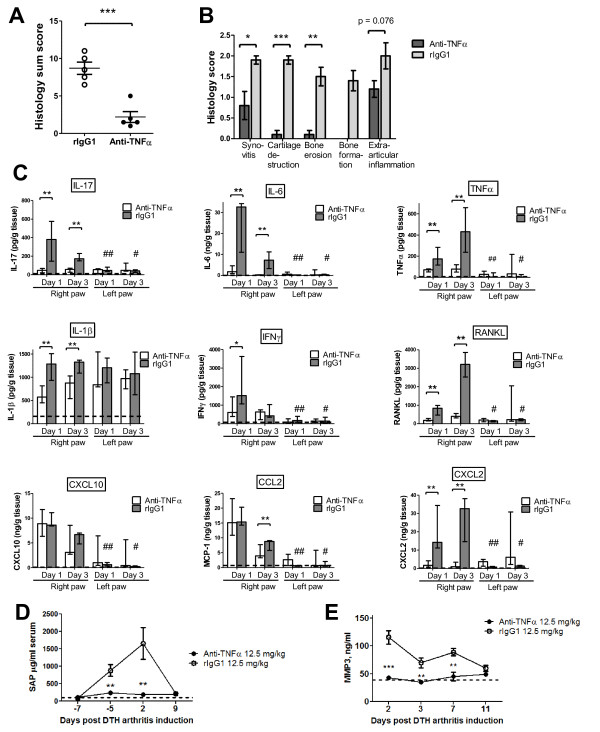Figure 7.

Effect of treatment with TNFα blocking biologics on histology, systemic and local inflammatory parameters. (a, b) Rat anti-mouse tumor necrosis factor-alpha monoclonal antibody (anti-TNFα) treatment led to a significant reduction in both the histology sum score and the individual parameters of the sum score in comparison with the control group. *P ≤ 0.05, **P ≤ 0.01, ***P ≤ 0.001. (c) Local profile of inflammatory mediators following administration of anti-TNFα (n = 5 per time point). Median and range are shown. Dotted line represents levels measured in naïve mice (n = 5). *P ≤ 0.05, **P ≤ 0.01, ***P ≤ 0.001, compared with value obtained from the mBSA-challenged paws taken from the isotype control group. #P ≤ 0.05, ##P ≤ 0.01, ###P ≤ 0.001, compared with the value obtained from the contralateral phosphate-buffered saline (PBS)-challenged paws taken from animals receiving identical treatments. (d) Serum levels of serum amyloid P component (SAP) in mice given prophylactic treatment with either anti-TNFα or isotype control antibody. Mean ± standard error of the mean (SEM) is shown (n = 5). **P ≤ 0.01, compared with the control group. Dotted line represents levels measured in naïve mice (n = 5). (e) Serum levels the enzyme MMP3 in mice given prophylactic treatment with either anti-TNFα mAb or isotype control antibody (rIgG1). Mean ± SEM is shown (n = 5). Dotted line represents levels measured in naïve mice (n = 5). **P ≤ 0.01, ***P ≤ 0.001, compared with the control group. CXCL, chemokine (C-X-C motif) ligand; IFNγ, interferon-gamma; IL, interleukin; MCP-1, monocyte chemo attractant protein 1; MMP3, matrix metalloproteinase 3; RANKL, receptor activator of nuclear factor kappa-B ligand; SAP, serum amyloid P component.
